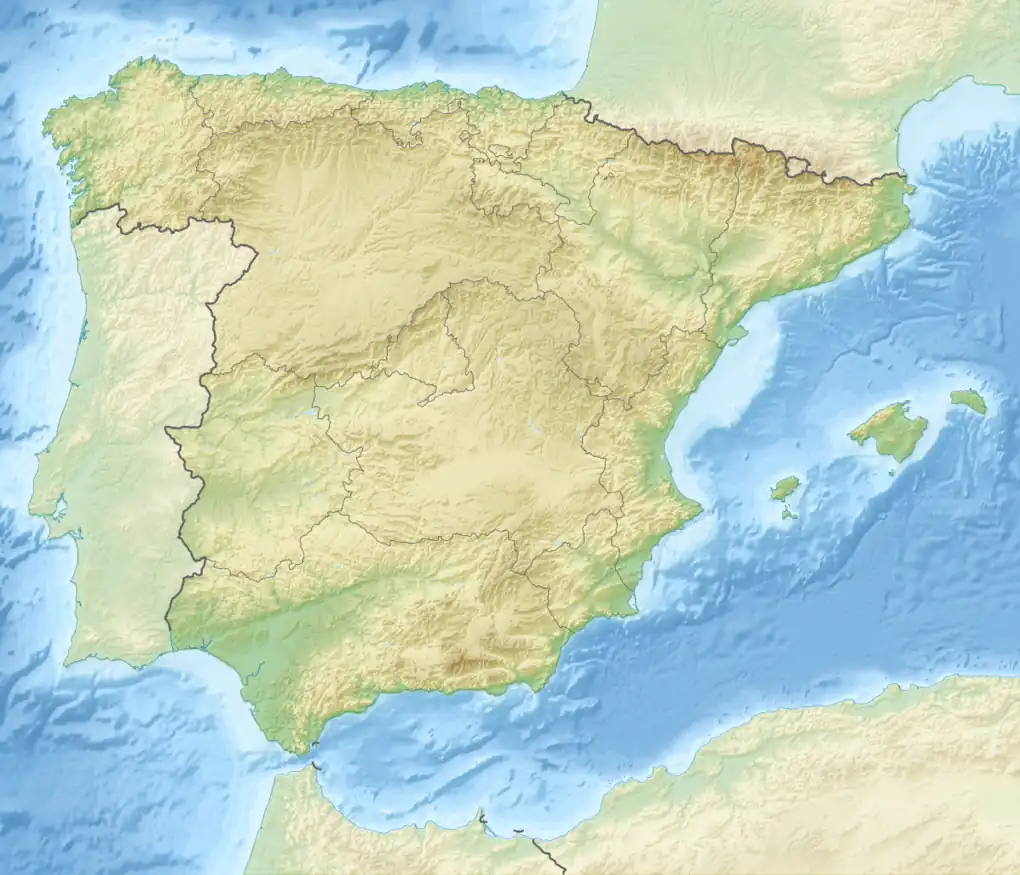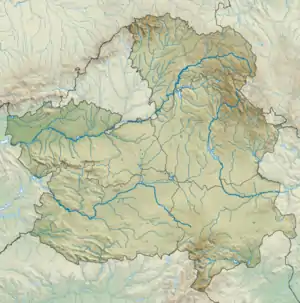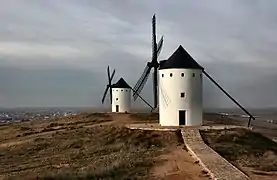Alcázar de San Juan | |
|---|---|
 | |
.svg.png.webp) Flag  Coat of arms | |
 Alcázar de San Juan Location in Spain.  Alcázar de San Juan Alcázar de San Juan (Castilla-La Mancha) | |
| Coordinates: 39°24′20″N 3°12′20″W / 39.40556°N 3.20556°W | |
| Country | Spain |
| Autonomous community | Castile-La Mancha |
| Province | Ciudad Real |
| Government | |
| • Mayor | Rosa Melchor (PSOE) |
| Area | |
| • Total | 666.78 km2 (257.45 sq mi) |
| Elevation | 644 m (2,113 ft) |
| Population (2018)[1] | |
| • Total | 30,686 |
| • Density | 46/km2 (120/sq mi) |
| Demonym | Alcazareños |
| Time zone | UTC+1 (CET) |
| • Summer (DST) | UTC+2 (CEST) |
| Postal code | 13600 |
| Website | Official website |
Alcázar de San Juan is a city and municipality of Spain located in the province of Ciudad Real, autonomous community of Castilla–La Mancha. It lies on the plain of La Mancha. From the 13th to the 19th century the history of Alcázar is strongly linked to the Grand Priory of the Order of St. John of Jerusalem. The city became a railway hub in the 19th century.
Geography
_Ciudad_Real_Central_Airport_%2526_Province%252C_Spain_(cropped).jpg.webp)
The municipality is part the large plain of La Mancha, standing at around 650 metres above sea level.[2] The area is drained by two tributaries of the Guadiana: the Cigüela and the Záncara,[2] located to the west and south of the urban centre, respectively.
The municipal area also features a number of endorheic saline lagoons surrounding the city, including the Alcázar de San Juan lagoon complex (lagoons of Camino de Villafranca, Las Yeguas and La Veguilla).[3]
Name
Its name is taken from an old moorish fortress (اَلْقَصْر in Arabic language), which was afterwards garrisoned by the knights of St John (San Juan in Spanish language).[4]
History
Middle ages
The area was conquered by Alfonso VI and then by Almoravids.[6] Following the new Christian conquest of the area, Alcázar was donated to three individual knights in 1150.[6] The heir of one of them transferred the hamlet to the Order of Santiago, who donated Alcázar to the Order of St. John in exchange for the hamlet of Criptana, and thus Alcázar took the name of "Alcázar de Consuegra", as it eventually became part of the Priory of St. John centered in Consuegra.[6] There is no historical record concerning the phase of Almohad occupation and archaeological findings are inconclusive.[6]
Alcázar was granted a population charter in 1241.[7] In 1292, Fernán Pérez, Commander of the Order, granted Alcázar the privilege of township (villazgo), which was confirmed by Sancho IV in that year and ratified by Ferdinand IV in 1300.[7]
Modern era
By the early 16th century, Alcázar thrived as town of the Priory of St. John (extending across territory in the current-day provinces of Toledo and Ciudad Real), parallel to the relative decline of its capital of Consuegra.[8] In the context of the struggles over the control of the priory and its ensuing split between Antonio de Estúñiga and Diego de Toledo, Alcázar reportedly became part of the latter's possessions.[9] The territory was not reunited until 1566.[9]

Railways arrived to Alcázar de San Juan in 1854, as part of the Aranjuez–Almansa line, and, in 1861, another line was opened (Alcázar–Manzanares–Daimiel–Almagro–Ciudad Real).[10]
The town was granted the title of city (ciudad) in April 1877.[11]
The famous Third Mixed Brigade (Tercera Brigada Mixta) of the Spanish Republican Army was established in Alcázar de San Juan in 1936 during the Spanish Civil War.[12]
Transport
Alcázar de San Juan has a reputation as railway hub.[13] It is part of the Madrid–Valencia and Alcázar de San Juan–Cádiz lines.
Since 2015,[14] the city has struggled for years to move forward with the project for the construction of the Plataforma Logística Intermodal "Mancha Centro",[15] a dry port.
Energy
Two solar thermal power plants owned by ACS/Grupo Cobra, Manchasol-1 and Manchasol-2, are located in the municipality.[16] They both use parabolic trough technology and produce 49.9 MW and 50 MW, respectively.[16]
Main sights
- Old windmills
- Tower of the Grand Prior (14th century)
- Church of St. Mary Major (13th-15th centuries)
- Church of St. Francis of Assisi (14th-15th centuries)
- Convent of St. Claire (16th century)
- Municipal Museum of Alcázar de San Juan (16th century)
 Old windmills
Old windmills Holy Trinity Church.
Holy Trinity Church. Saint Francis Church.
Saint Francis Church.
International relations
- Twin towns and sister cities
Alcázar de San Juan is twinned with:
- Mâcon, France (1980)[17]
- Guanajuato, Mexico (2014).[18]
Notable people
- José Antonio Redondo, cyclist.
- Ángel Lizcano Monedero y Esteban, (1846-1929) was a Spanish painter and illustrator.[19]
References
- ↑ Municipal Register of Spain 2018. National Statistics Institute.
- 1 2 Ruiz Sabina & Ocaña Carretón 2011–2012, p. 242.
- ↑ Carricondo Sánchez, Sánchez Zarca & Vaquero 2008, p. 34.
- ↑ One or more of the preceding sentences incorporates text from a publication now in the public domain: Chisholm, Hugh, ed. (1911). "Alcázar de San Juan". Encyclopædia Britannica. Vol. 1 (11th ed.). Cambridge University Press. p. 518.
- ↑ Rodríguez González, Daniel (26 September 2020). "Celebrando el 'Día Mundial del Turimo' en Alcázar de San Juan". Cadena SER.
- 1 2 3 4 Ruiz Sabina & Ocaña Carretón 2011–2012, p. 244.
- 1 2 Galende Díaz & Ávila Seoane 2018, p. 12.
- ↑ Gómez Vozmediano 1996, p. 139.
- 1 2 Barquero Goñi 1998, p. 556.
- ↑ "El ferrocarril en Ciudad Real: 166 años de historia, 108 accidentes y 181 fallecidos". Lanza. 16 February 2020.
- ↑ "Alcázar de San Juan conmemora los 140 años de su proclamación como ciudad por Alfonso XII". Lanza Digital. 10 April 2017.
- ↑ SBHAC - Brigadas Mixtas del Ejército Popular, 3ª Brigada Mixta
- ↑ Guía: Alcázar de San Juan 'corazón de La Mancha'. 1966.
- ↑ "Alcázar de San Juan presenta la Plataforma Logística 'Mancha Centro', con influencia en más de 93.000 empresas". Europa Press. 23 October 2015.
- ↑ Pobes, Ana (24 March 2019). "Alcázar mira al mundo logístico". La Tribunal de Ciudad Real.
- 1 2 "Appendix D. List of operating CSP plants". Port Augusta Solar Thermal Generation. Feasibility Study (PDF). Australian Renewable Energy Agency. 1 July 2014.
- ↑ "Viaje de hermanamiento a la ciudad francesa de Mâcon". ABC. 10 July 2012.
- ↑ "Miguel de Cervantes ya es hijo predilecto de Alcázar". La Tribuna de Ciudad Real. 9 November 2014.
- ↑ Online J. Ruyz, "El 150 aniversario del pintor Ángel Lizcano", Añil: Cuadernos de Castilla - La Mancha ISSN 1133-2263, Nº 11, 1996, pgs. 45-46
- Bibliography
- Barquero Goñi, Carlos (1998). "Disputas por el Priorato del Hospital en Castilla durante los siglos XIV y XV". Hispania. Revista Española de Historia. Madrid: Editorial CSIC. 58 (199): 537–557. doi:10.3989/hispania.1998.v58.i199.647. ISSN 0018-2141. S2CID 159809563.
- Carricondo Sánchez, J.F; Sánchez Zarca, M.T.; Vaquero, A. (2008). Patrimonio Geológico y Paleontológico de Alcázar de San Juan. Relevancia paleontológica del yacimiento de troncos fósiles silicificados de plantas vasculares en la comarca manchega de Alcázar de San Juan (PDF). Alcázar de San Juan: Patronato Municipal de Cultura. ISBN 978-84-87106-86-6.
- Galende Díaz, Juan Carlos; Ávila Seoane, Nicolás (2018). "Alcázar de San Juan y su historia documental: estudio de una provisión real de la Chancillería de Granada (1573)". Baetica. Estudios de Historia Moderna y Contemporánea. Málaga: UMA Editorial (38): 9–28. doi:10.24310/BAETICA.2018.v0i38.4895. hdl:10630/19848. ISSN 0212-5099. S2CID 202361235.
- Gómez Vozmediano, Miguel Fernando (1996). "La revuelta de las Comunidades en la Mancha (1519-1531)". Chronica Nova. Revista de Historia Moderna de la Universidad de Granada. Granada: Editorial Universidad de Granada (23): 135–169. doi:10.30827/cn.v0i23.2107 (inactive 2023-08-01). hdl:10481/50500. ISSN 0210-9611.
{{cite journal}}: CS1 maint: DOI inactive as of August 2023 (link) - Ruiz Sabina, Juan Ángel; Ocaña Carretón, Andrés (2011–2012). "Estructuras de transformación agrícola en el barrio de Santa María en Alcázar de San Juan (Ciudad Real)". Anales de Prehistoria y Arqueología. Murcia: Ediciones de la Universidad de Murcia (27–28): 241–252. ISSN 0213-5663.